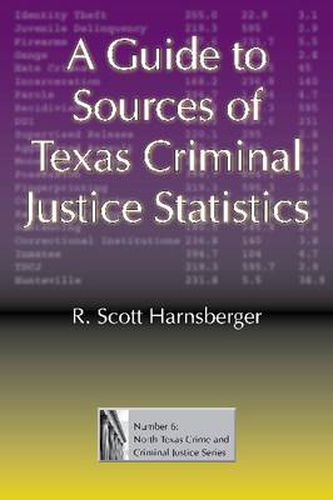Readings Newsletter
Become a Readings Member to make your shopping experience even easier.
Sign in or sign up for free!
You’re not far away from qualifying for FREE standard shipping within Australia
You’ve qualified for FREE standard shipping within Australia
The cart is loading…






This title is printed to order. This book may have been self-published. If so, we cannot guarantee the quality of the content. In the main most books will have gone through the editing process however some may not. We therefore suggest that you be aware of this before ordering this book. If in doubt check either the author or publisher’s details as we are unable to accept any returns unless they are faulty. Please contact us if you have any questions.
This reference work was compiled as a resource for those needing assistance in locating Texas criminal justice statistics. R. Scott Harnsberger has compiled more than 600 entries describing statistical sources for Texas crime; criminals; law enforcement; courts and sentencing; adult and juvenile corrections; capital punishment and death row; victims of crime; driving/boating under the influence; traffic fatalities; substance abuse and treatment; polls and rankings; and fiscal topics such as appropriations, revenues, expenditures, and federal aid.
The sources for these statistics originate primarily, but not exclusively, from federal and State of Texas agencies, boards, bureaus, commissions, and departments. The following types of publications are included: annual, biennial, and biannual reports; reports issued in series; analytic and research reports; statistical compilations; budgets and other fiscal documents; audits, inspections, and investigations; census publications; polls; projections; rankings; surveys; continuously updated online resources; and datasets.
Harnsberger has annotated the entries to provide sufficient detail to enable users to decide whether the listed resources merit further investigation. Additional notes contain URLs and information regarding the scope of the published data; title changes; related publications; and the availability of earlier data, previous editions, online tables, and datasets.
This book will prove to be a valuable resource for students, faculty, researchers, government officials, and individuals in the law enforcement, correctional, and judicial professions.
$9.00 standard shipping within Australia
FREE standard shipping within Australia for orders over $100.00
Express & International shipping calculated at checkout
This title is printed to order. This book may have been self-published. If so, we cannot guarantee the quality of the content. In the main most books will have gone through the editing process however some may not. We therefore suggest that you be aware of this before ordering this book. If in doubt check either the author or publisher’s details as we are unable to accept any returns unless they are faulty. Please contact us if you have any questions.
This reference work was compiled as a resource for those needing assistance in locating Texas criminal justice statistics. R. Scott Harnsberger has compiled more than 600 entries describing statistical sources for Texas crime; criminals; law enforcement; courts and sentencing; adult and juvenile corrections; capital punishment and death row; victims of crime; driving/boating under the influence; traffic fatalities; substance abuse and treatment; polls and rankings; and fiscal topics such as appropriations, revenues, expenditures, and federal aid.
The sources for these statistics originate primarily, but not exclusively, from federal and State of Texas agencies, boards, bureaus, commissions, and departments. The following types of publications are included: annual, biennial, and biannual reports; reports issued in series; analytic and research reports; statistical compilations; budgets and other fiscal documents; audits, inspections, and investigations; census publications; polls; projections; rankings; surveys; continuously updated online resources; and datasets.
Harnsberger has annotated the entries to provide sufficient detail to enable users to decide whether the listed resources merit further investigation. Additional notes contain URLs and information regarding the scope of the published data; title changes; related publications; and the availability of earlier data, previous editions, online tables, and datasets.
This book will prove to be a valuable resource for students, faculty, researchers, government officials, and individuals in the law enforcement, correctional, and judicial professions.